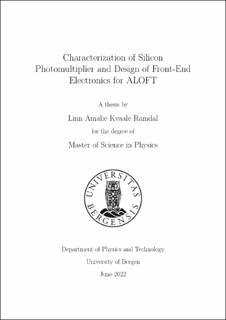Characterization of Silicon Photomultiplier and Design of Front-End Electronics for ALOFT
Master thesis
Permanent lenke
https://hdl.handle.net/11250/3000771Utgivelsesdato
2022-06-01Metadata
Vis full innførselSamlinger
- Master theses [170]
Sammendrag
ALOFT is an aircraft campaign led by Birkeland Centre for Space Science at University of Bergen. The primary goal of the campaign is to look for Terrestrial Gamma Ray Flashes and gamma-ray glows, both high-energetic phenomena associated with thunderstorms. Among the several instruments to be used in the campaign is the UIB-BGO instrument, which will be upgraded with two new gamma-ray detectors. The new gamma-ray detectors will consist of two LYSO-scintillators of different sizes coupled to Silicon Photomultipliers. This thesis contributes to these detectors by characterizing the Silicon Photomultipliers and designing front-end electronics for the Silicon Photomultiplier, appropriate for the application. The signal shape, height, and length from the Silicon Photomultiplier are verified through measurement. Additionally, they are used to conclude with the best configuration of the Silicon Photomultiplier, with timing in mind. Other important characteristics are calculated, such as temperature sensitivity and linearity. The signal shape of Silicon Photomultiplier coupled to the LYSO-scintillator is also verified. A design of front-end electronics for the Silicon Photomultiplier is made; the challenge here was the large and fast signal from the Silicon Photomultiplier and its large detector capacitance. A solution of preamplifiers has been designed to resolve this. And a design of the shaping circuit is made; this reduces noise but still retains the fast signal. The needed parameters of the front-end electronics are calculated and verified through simulation. The specific components to be used are verified in simulations; additionally, the preamplifier is physically tested with Silicon Photomultiplier input.
